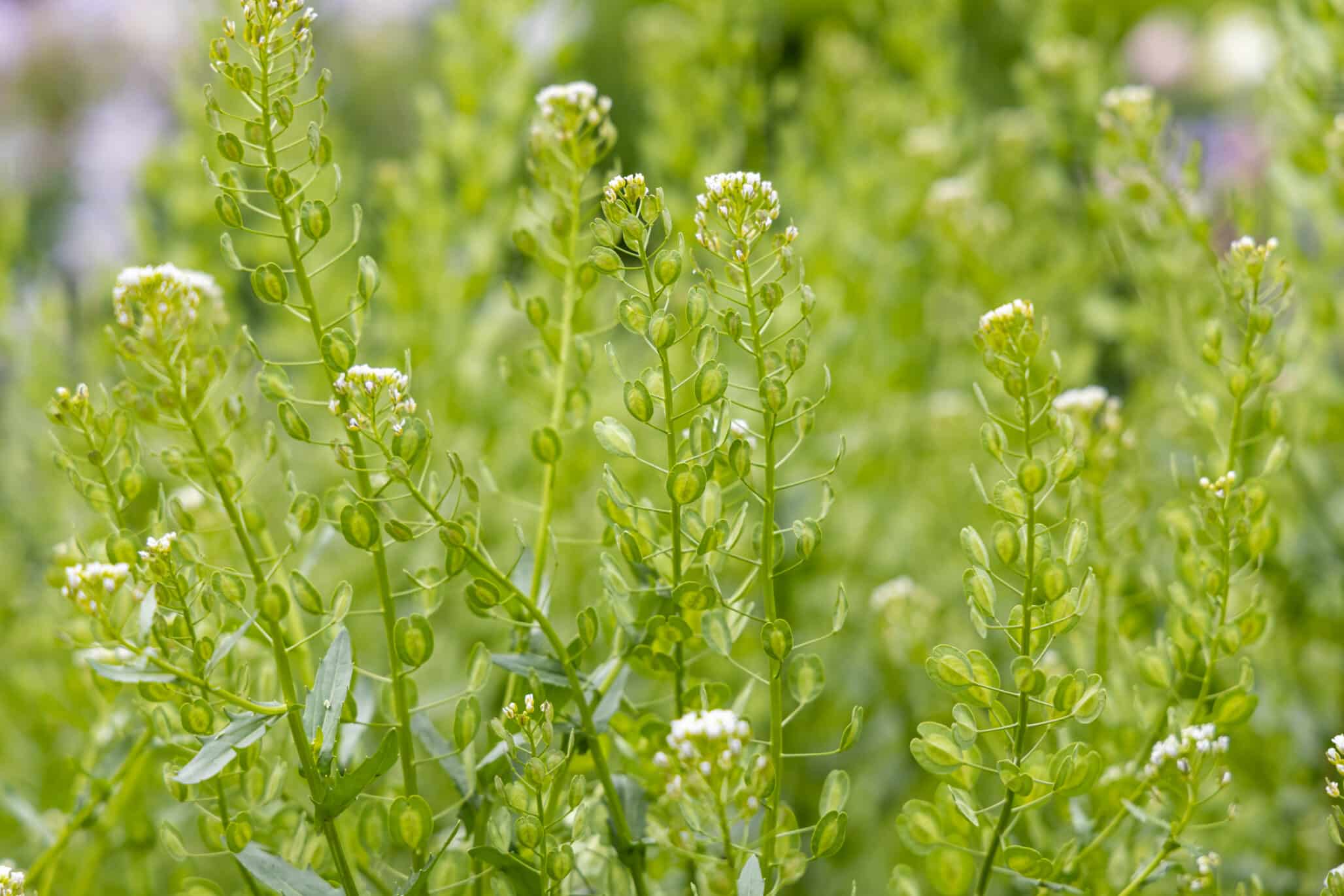Scientists mentioning the word “mutation” may invoke sinister images of darkened labs and bubbling beakers. For John Sedbrook, however, a genetic mutation is a means to help the planet.
An ISU professor of genetics, Sedbrook is devoted to integrated plant biology and bioenergy, meaning his research focuses on bringing out positive genetic traits in plants. “We’re making mutations that are good,” he says. “That is the whole story behind domestication, these very rare mutations that make a plant into a crop.”
Sedbrook is one leader on a scientific team that received a $10 million grant from the United States Department of Agriculture (USDA) to turn plants into sources of biofuels. The grant, which will assist several institutions, concentrates on converting the weed pennycress into a viable crop planted by farmers to cover their land during the winter months.
“The beauty of Thlaspi arvense, or pennycress, is that it grows from fall to spring,” Sedbrook says. “This would not only help the environment, but also produce oilseeds that farmers can sell in these economically challenging times.”
The grant will enable Illinois State to expand research, education, and outreach for domesticating pennycress for use in biodiesel, jet fuel, and animal feed. If adopted more widely, Sedbrook believes cover crops can help mitigate environmental damage.
“Plants like pennycress take carbon dioxide out of the atmosphere to grow. Instead of adding to carbon in the atmosphere by digging for fossil fuels, you’re taking carbon that’s already there. So it’s a zero-sum game,” Sedbrook says in explaining the project that is just one of his research initiatives, which spans decades.
All of Sedbrook’s scholarly endeavors are based on his underlying interest in identifying molecular genetic mechanisms in plants that can be exploited to improve crops for human use without compromising the plant’s health. A founding member of the Great Lakes Bioenergy Research Center funded by the U.S. Department of Energy, his lab identified beneficial mutations in grasses — which can improve switchgrass, Miscanthus, and corn stems and leaves — for their use in generating biofuels.
Sedbrook prepared for such scholarly work by completing a doctorate in genetics at the University of Wisconsin in Madison, with postdoctoral study undertaken at Stanford University in California. A recipient of ISU’s University Research Initiative Award and the College of Arts and Sciences Outstanding College Researcher Award, Sedbrook secured millions in external funding for his research prior to the $10 million grant.
The funds advance research that will potentially impact farmers and fuel production across the country. In the Midwest alone, nearly 80 million acres of land devoted to corn and soybeans sit dormant in the winter months.
The planting of pennycress could provide additional income beyond the typical growing season, while creating a positive force for the environment. Sedbrook’s research results in estimates that oil from pennycress seeds has the potential to produce three billion gallons of fuel per year. With the right infrastructure, that amount would help offset a reliance on fossil fuels, while also protecting and enriching the soil.
“Instead of nitrogen from fertilizers leaching into the streams after harvest, pennycress plants will soak it up. So the plants are improving soil health and water quality as well,” he says, noting that converting seeds into useable materials is not a new concept. In the 1960s, the almost unknown rapeseed was modified to create canola oil, which is now a billion-dollar-a-year crop.
“This is the same path we’re taking with pennycress,” Sedbrook says, acknowledging that the conversion of rapeseed laid the foundation for the current initiative. The work has involved making two key genetic changes to pennycress seeds to make them edible and more nutritious. Because wild strains of pennycress do not always grow uniformly, Sedbrook’s team has worked to improve seed germination and crop establishment.
Pennycress seedpods break open easily, resulting in about 20% of the seeds falling to the ground before they can be harvested. Students in Sedbrook’s lab have genetically fixed the “pod shatter” problem.
Several Illinois State faculty and staff members will join Sedbrook to lend their expertise understanding the challenges and opportunities that come with domesticating pennycress. Professor of Water Ecology Bill Perry noted that the work fits in with the U.S. Environmental Protection Agency’s hopes to protect water resources within Illinois and in other downstream states.
“Our research may assist in meeting the goals of the Illinois Nutrient Reduction Strategy, not only helping to keep nutrients in the fields, but also providing an economic return to during the offseason,” says Perry, whose research will complement that of Assistant Professor of Crop Science Nicholas Heller and Professor of Soil Science Rob Rhykerd of the University’s Department of Agriculture.
Grant funds will also support outreach to farmers and the agricultural community. Willy Hunter, Rebekka Darner, and Matthew Hageman of Illinois State’s Center for Mathematics, Science, and Technology will engage with area 4-H programs.
“We’re meeting with 4-H administrators to begin to strategize how to demonstrate different aspects of pennycress,” Sedbrook says. Students in 4-H could show how to extract oil, how pennycress roots reduce soil erosion, or explain the science behind biofuels.
Sedbrook hopes the new crop will be a key player in the fight against climate change. “Science indisputably shows that climate change is a real and a present problem that we need to address as soon as possible,” he says. “Pennycress can help do that while providing extra income to rural communities. It’s a win-win.”
The grant also benefits those working toward commercializing pennycress. Illinois State researchers join colleagues from Western Illinois University, the University of Minnesota, the Ohio State University, the University of Wisconsin-Platteville, and the St. Louis-based crop development company CoverCress Inc. in creating the USDA-funded Integrated Pennycress Research Enabling Farm and Energy Resilience (IPREFER) program.
IPREFER members look to establish an infrastructure that will enable farmers to not only plant and harvest domesticated pennycress, but also deliver the seeds to processing plants that will convert them to fuel and feed.













